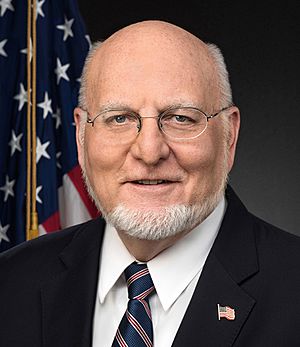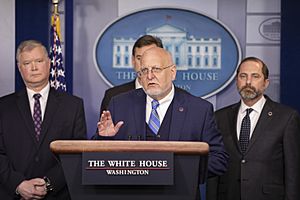Robert R. Redfield facts for kids
Quick facts for kids
Robert R. Redfield
|
|
|---|---|

Redfield in 2018
|
|
| 18th Director of the Centers for Disease Control and Prevention | |
| In office March 26, 2018 – January 20, 2021 |
|
| President | Donald Trump |
| Deputy | Anne Schuchat |
| Preceded by | Brenda Fitzgerald |
| Succeeded by | Rochelle Walensky |
| Personal details | |
| Born |
Robert Ray Redfield Jr.
July 10, 1951 Bethesda, Maryland, U.S. |
| Education | Georgetown University (BS, MD) |
| Military service | |
| Allegiance | |
| Branch/service | |
| Years of service | 1977–1996 |
| Rank | |
| Unit | Medical Corps |
Robert Ray Redfield Jr. (born July 10, 1951) is an American virologist, which is a scientist who studies viruses. He was the director of the U.S. Centers for Disease Control and Prevention (CDC) from 2018 to 2021. The CDC is a top health organization in the United States that works to protect the country from diseases.
Contents
Early Life and Schooling
Robert Ray Redfield Jr. was born on July 10, 1951. His parents were both scientists at the National Institutes of Health (NIH), a major center for medical research. This inspired him to go into medicine. Sadly, his father passed away when he was only four years old.
Redfield went to Georgetown University. While in college, he worked in labs at Columbia University. There, he studied retroviruses, a type of virus, and how they can cause diseases in people. He earned his bachelor's degree in 1973 and his medical degree in 1977, both from Georgetown.
Career in the U.S. Army
After medical school, Redfield joined the U.S. Army. He worked as a doctor and researcher at the Walter Reed Army Medical Center in Washington, D.C. He specialized in infectious diseases, which are illnesses that can spread from person to person.
During the 1980s, Redfield became a leading researcher on HIV. He and his team made important discoveries about the virus. He published many scientific papers and worked to turn research into real treatments for patients. For his work, he received several awards.
During this time, Redfield also worked with groups that had specific ideas about how to prevent the spread of HIV. Some people disagreed with these ideas. He also wrote the introduction to a book called "Christians in the Age of AIDS."
Redfield retired from the army in 1996 with the rank of colonel.
HIV Vaccine Research
In the early 1990s, Redfield led a study for an experimental HIV vaccine. A vaccine is a medicine that helps your body fight off a virus. Based on his early data, the U.S. government provided $20 million to a company to develop the vaccine.
Redfield presented his findings at a big science conference in 1992. He said that early results showed the vaccine might be helping patients. However, other scientists were not sure about the data, and the vaccine later proved to be ineffective.
This led to a disagreement among scientists. An investigation by the U.S. Army in 1993 looked into how the data was presented. The investigation found some issues but concluded that no serious wrongdoing had occurred. Redfield continued his research, and a final study published in 2000 confirmed the vaccine did not work.
Work at the University of Maryland
In 1996, Redfield co-founded the Institute of Human Virology at the University of Maryland School of Medicine. This research center is dedicated to studying and treating viruses that cause long-term illnesses in people.
At the university, Redfield was a professor of medicine and microbiology. He was known for his research on how HIV is transmitted and for creating a system to track the stages of HIV infection. This system is now used all over the world.
Under his leadership, the number of patients treated at the university's clinics grew from 200 to about 6,000. His team also helped over a million people in Africa and the Caribbean. They won over $600 million in funding for their research.
In 2009, he was interviewed for a film called House of Numbers. Later, some scientists who were in the film said their comments were used in a misleading way to support unproven ideas.
Director of the CDC

Robert Redfield became the director of the CDC on March 26, 2018. He was appointed by President Donald Trump. His appointment was controversial for some people. Some groups supported him, but others criticized him for his past views on disease prevention.
When he started, Redfield said the CDC would be "science-based and data-driven." This means that all its decisions would be based on scientific facts and evidence.
There was also some debate about his salary, which was higher than past directors. A few days after starting, Redfield asked for his salary to be lowered so it would not be a distraction from the CDC's work.
Leading During the COVID-19 Pandemic
Redfield was the head of the CDC when the COVID-19 pandemic began. He was a member of the White House Coronavirus Task Force, which was created to manage the country's response to the virus.
In February 2020, he warned that the virus would likely be around for a long time. This was different from what President Trump was saying at the time.
Early in the pandemic, the first COVID-19 tests sent out by the CDC did not work correctly. This caused a major delay in testing across the country. It took about three weeks to fix the problem. Later investigations found that the CDC had made mistakes in how it created the tests.
Redfield sometimes disagreed with the White House on how to handle the pandemic.
- On Masks: In July 2020, Redfield said that if everyone wore a mask, the U.S. could get the virus under control in a few months. President Trump disagreed, saying he did not support a national rule for masks.
- On Vaccines: In September 2020, Redfield told Congress that a COVID-19 vaccine would likely not be available for everyone until the middle of 2021. President Trump said Redfield was "confused" and that a vaccine would be ready much sooner.
- On Cruise Ships: Redfield wanted to stop cruise ships from sailing until 2021 to prevent the spread of the virus. However, he was overruled by Vice President Mike Pence, and the order was set to end sooner.
Some experts praised Redfield's commitment to public health, while others felt he was not effective at standing up to political pressure.
Life After the CDC
After leaving the CDC in 2021, Redfield shared his opinion on how the COVID-19 pandemic started. He said he believes the virus most likely came from a laboratory in Wuhan, China. He said this was his personal opinion as a virologist and did not mean it was released on purpose.
He explained that the virus spread very easily between people from the very beginning. He felt this made a natural jump from animals to humans less likely. He suggested it might have been the result of gain-of-function research. This is a type of research where scientists try to make a virus more transmissible to study it.
His opinion is one of several theories about the origin of COVID-19 that scientists are still investigating. Redfield said he received threats from people who disagreed with his view. In 2023, he repeated his opinion during a U.S. congressional hearing about the pandemic's origins.
Personal Life
Redfield is married to Joyce Hoke. They met when he was a medical student and she was a nursing assistant. They have six children and nine grandchildren.
See also
- HIV/AIDS research
- COVID-19 pandemic in the United States

